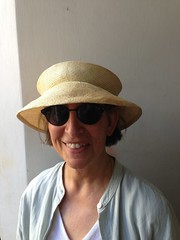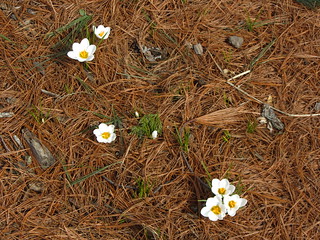
I'm a writer, publishing both as SJ Rozan and, with Carlos Dews, as Sam Cabot. (I'm Sam, he's Cabot.) Here you can find links to my almost-daily blog posts, including the Saturday haiku I've been doing for years. BUT the blog itself has moved to my website. If you go on over there you can subscribe and you'll never miss a post. (Miss a post! A scary thought!) Also, I'll be teaching a writing workshop in Italy this summer -- come join us!
Read/Post Comments (1)

Kabuki
Went to see a famous Japanese Kabuki company the other night, my first Kabuki. They're in NY for 2 weeks, completely sold out, including 2 "reserved" peformances which I assume are for Japanese glitterati. Part of the reason they sold out so early is that, for the sake of authenticity, they put up a cloth-roofed, wood-sided Kabuki tent in the park at Lincoln Center. It only holds 500+ people, on low bench seats. Usually these tents have a balcony as well, but the exigencies of creating a temporary building plus NYC building codes made that too complicated. So there's a black-and-white-with-occasional-spots-of-color brush-stroke frieze all around the inside depicting a rowdy but entranced audience peering down.
Which pretty much described the real audience, as well. Many Japanese women in kimono (I learned reading Sujata Massey that the plural of "kimono" is "kimono") and Japanese men in dark suits. Many white folks and black folks, too. Everyone totally entralled, even the large percentage of the audience without translation devices. I was one of those: I didn't want to be distracted from the actors by a translation, and I had an outline of the action of each act. Like the Chinese operas that come to NY -- except for the "Peony Pavilion" in 2000 -- this was an excerpted show: it was "The Mirror of Osaka" which apparently usually takes 4 days. We saw 3 hours. So we got a sampling of each kind of scene, each mood. You didn't need a translation to understand devotion, fear, longing, or rage as these actors portrayed them. And the comedy and choreographed fight scenes were terrific. And of course the gorgeous Japanese textiles of the costumes!
Kabuki is spoken, not sung, but spoken in a stylized manner just as the acting is stylized. This production, which is set during a festival, is accompanied by drumming, and at one point the drummers did an extended interlude -- thrilling. I was lucky in my seat: not only was it a perfect distance from the stage to read the actors' expressions -- important in Kabuki; they really do make the faces you see in the woodcuts -- but I was on the side where most of the performers' entrances and exits were made on a ramp through the audience.
It was a general blast, and I wish I could see more. Last summer when I was in Japan it wasn't Kabuki season, just like summer in NY isn't opera season. But next time I go, I'm going to make sure it is.
Which pretty much described the real audience, as well. Many Japanese women in kimono (I learned reading Sujata Massey that the plural of "kimono" is "kimono") and Japanese men in dark suits. Many white folks and black folks, too. Everyone totally entralled, even the large percentage of the audience without translation devices. I was one of those: I didn't want to be distracted from the actors by a translation, and I had an outline of the action of each act. Like the Chinese operas that come to NY -- except for the "Peony Pavilion" in 2000 -- this was an excerpted show: it was "The Mirror of Osaka" which apparently usually takes 4 days. We saw 3 hours. So we got a sampling of each kind of scene, each mood. You didn't need a translation to understand devotion, fear, longing, or rage as these actors portrayed them. And the comedy and choreographed fight scenes were terrific. And of course the gorgeous Japanese textiles of the costumes!
Kabuki is spoken, not sung, but spoken in a stylized manner just as the acting is stylized. This production, which is set during a festival, is accompanied by drumming, and at one point the drummers did an extended interlude -- thrilling. I was lucky in my seat: not only was it a perfect distance from the stage to read the actors' expressions -- important in Kabuki; they really do make the faces you see in the woodcuts -- but I was on the side where most of the performers' entrances and exits were made on a ramp through the audience.
It was a general blast, and I wish I could see more. Last summer when I was in Japan it wasn't Kabuki season, just like summer in NY isn't opera season. But next time I go, I'm going to make sure it is.
Read/Post Comments (1)
Previous Entry :: Next Entry
Back to Top